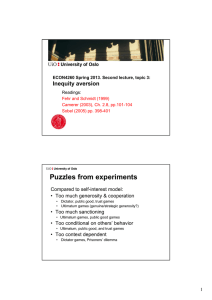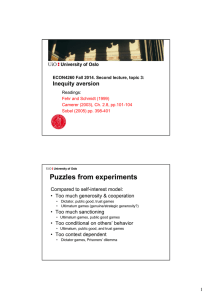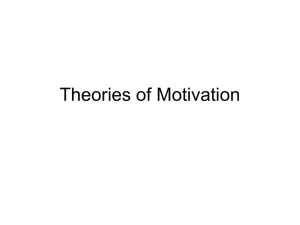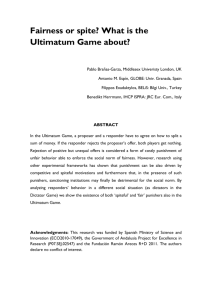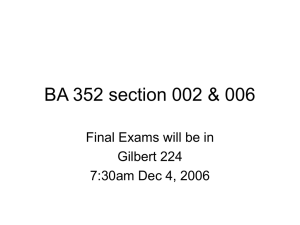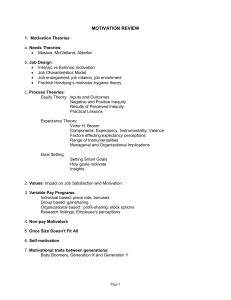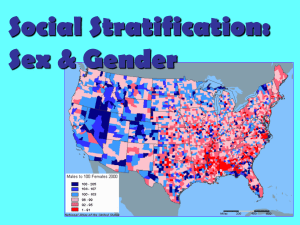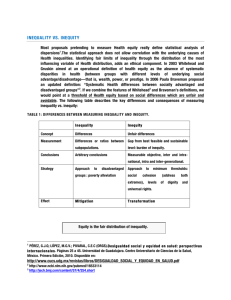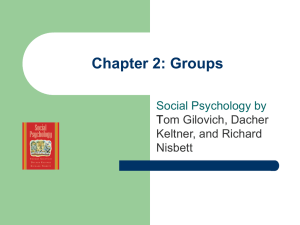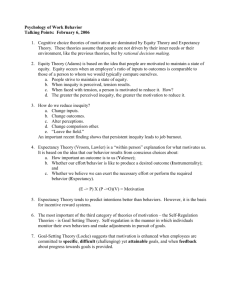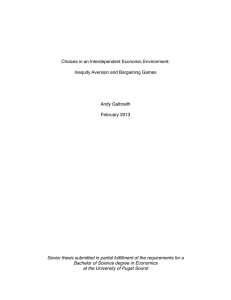Inequity aversion Puzzles from experiments Compared to self-interest model:
advertisement
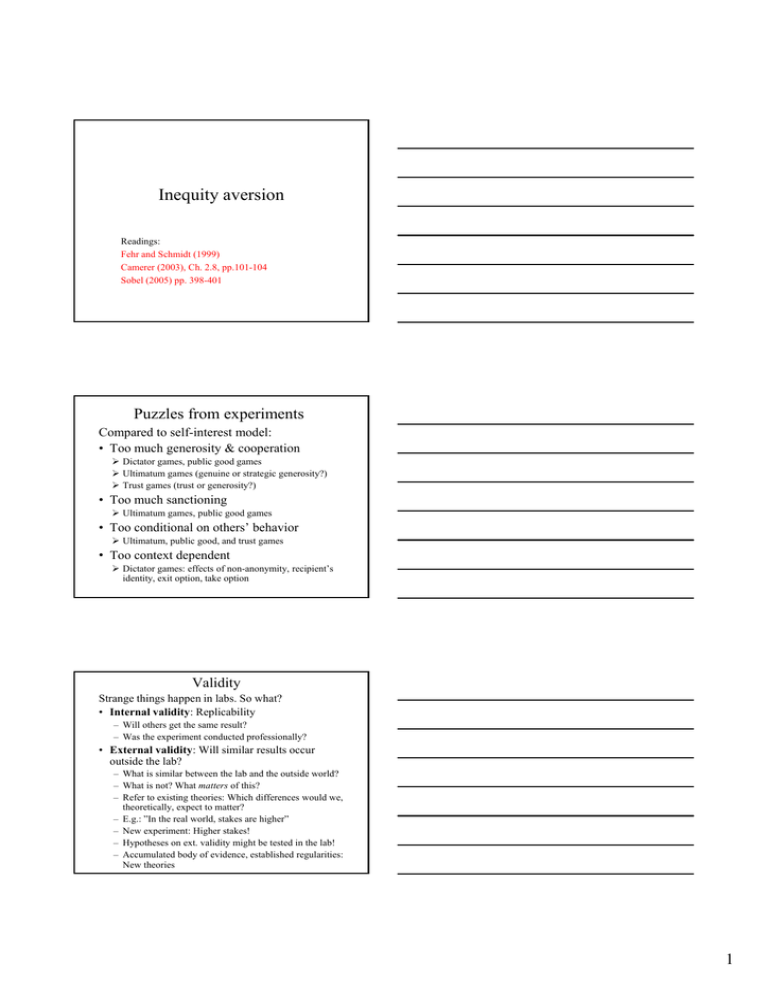
Inequity aversion
Readings:
Fehr and Schmidt (1999)
Camerer (2003), Ch. 2.8, pp.101-104
Sobel (2005) pp. 398-401
Puzzles from experiments
Compared to self-interest model:
• Too much generosity & cooperation
Dictator games, public good games
Ultimatum games (genuine or strategic generosity?)
Trust games (trust or generosity?)
• Too
T muchh sanctioning
ti i
Ultimatum games, public good games
• Too conditional on others’ behavior
Ultimatum, public good, and trust games
• Too context dependent
Dictator games: effects of non-anonymity, recipient’s
identity, exit option, take option
Validity
Strange things happen in labs. So what?
• Internal validity: Replicability
– Will others get the same result?
– Was the experiment conducted professionally?
• External validity: Will similar results occur
outside the lab?
– Wh
Whatt is
i similar
i il between
b t
the
th lab
l b andd the
th outside
t id world?
ld?
– What is not? What matters of this?
– Refer to existing theories: Which differences would we,
theoretically, expect to matter?
– E.g.: ”In the real world, stakes are higher”
– New experiment: Higher stakes!
– Hypotheses on ext. validity might be tested in the lab!
– Accumulated body of evidence, established regularities:
New theories
1
Proposed explanations
• Inequity aversion
– A preference for equal payoffs
• Reciprocity
– A preference for repaying kindness with kindness and
meanness with meanness
• Altruism
– Caring for others’ payoff, or others’ utility
• Preferences for social approval
– Prefers to be liked by others
• All these explanations involve ”non-standard”
preferences (note: not irrationality!).
Explanations: ad hoc vs. consistency
•
Anything can be ”explained” by ad hoc adjustments of
preference assumptions!
A shares with others, B does not
•
–
•
A has a preference for sharing, B does not?
A sanctions others, B does not
–
•
1
1.
A has a preference for sanctioning others, B does not?
Two approaches:
Sti k to
Stick
t self-interest
lf i t
t model,
d l look
l k for
f mechanisms
h i
making giving or sanctioning individually profitable
–
–
Giving → social status → well-paid job → income
Sanctioning → reputation as (irrationally) tough type → better
bargaining position → higher income
Experiments: Can control for such mechanisms
2.
Adjust preference assumptions, but require
–
–
General applicability (consistent w. wide array of data)
and/or: Based on knowledge from other disciplines (psychology,
anthropology, biology, neurology).
Preferences for equity
• What if some individuals dislike inequity?
– Utility: Increasing in own income and in equity
• Possible formalization (e.g.):
U i u ( xi ) ( x j xi ) 2
0
– Utility increasing in own income, decreasing in
absolute distance between i and j’s income
(symmetrical)
– Other possibility: Utility depends on relative
relationship between own and others’ income
(see Bolton and Ockenfels 2000)
2
Fehr and Schmidt (1999): A model of
inequity aversion
• Individuals care about own income, advantageous
inequity, and disadvantageous inequity
– Suffer more from disadvantageous than advantageous
inequity
– Simplification:
Si lifi ti
Linearity
Li
it
U i xi i maxx j xi ,0 i maxxi x j ,0
– Can alternatively be written:
U i xi i ( xi x j ) if xi x j
U i xi i ( x j xi ) if xi x j
Fehr and Scmidt: Inequity aversion
U i xi i maxx j xi ,0 i maxxi x j ,0
where i≠j, and βi ≤ αi, 0 ≤ βi < 1
Ui (xj|xi)
45º line
i’s utility as a
function of j’s
income, for a
given xi
xj
xi
All else given, i prefers j’s income to equal hers; i’s utility
declines in their income difference, more so if i herself is worst
off.
Ultimatum game: Inequity averse responder
• Responder, B, prefers high payoff to himself, and
equality between himself and the proposer, A.
• Choice:
– Reject: {xA,xB}={0,0}
– Accept: {xA,xB}={(1- s)X, sX}
• Offered share s = 0.5:
– Accept yields same income difference as reject. Accept
yields more income than reject. Offer is accepted.
• Offered share s > 0.5:
– Accept: higher income difference than reject. Accept
yields more income. Assumption βi < 1: One will never
throw away income to avoid advantageous inequality.
Offer is accepted.
3
Inequity averse responder (cont.)
• Offered share s < 0.5:
– Accept: higher income difference than reject.
– Accept yields more income.
– No upper boundary on αi: We may throw away income
to avoid disadvantageous inequality.
U B xB B maxx A xB ,0 B maxxB x A ,0
U B ( accept ) sX B [(1 s ) X sX ]
sX B [ X 2 sX ] X [ s B (1 2 s )]
U B ( reject ) 0
X [ s B (1 2 s)] 0
• Reject is preferred if
B
• i.e. if s
1 2 B
• Note: X doesn’t matter!
Example
• αB = 2, βB = 0.4
• Offer from Proposer (A): s = 0.2
U B xB i maxx A xB ,0 B maxxB x A ,0
U B (accept )
0.2
0 2 X 2 max 0.8
0 8 X 00.2
2 X , 0 00.4
4 max 00.22 X 0.8
0 8 X , 0
= 0.2X - 2· 0.6X
= X (0.2 – 1.2)
=-X
U B ( reject ) 0
• B will reject, regardless of the size of the ”pie” to be
shared.
Inequity averse Proposer
• Prefers high payoff to himself (A) and equality
between himself and the responder (B).
• Offered share s = 0.5:
– If accepted: Yields max. equality, but less than max.
income
– Both self-interested and inequality-averse
q
y
responders
p
will accept s = 0.5
• Offered share s > 0.5:
– If accepted: Yields less income than s = 0.5, and less
equality
– Proposer will never offer s > 0.5
4
Inequity averse Proposer (cont.)
• Offered share s < 0.5:
– If accepted: Lower s, higher income, but less equality
– Which is most important?
– A’s utility when s ≤ 0.5, given that B accepts:
U A x A A max x B x A , 0 A max x A x B , 0
(1 s ) X A [(1 s ) X sX
X]
X ( s (2 A 1) 1 A )
– This is increasing in s whenever βA > 0.5
– If acceptance were not a concern (dictator game), A
would offer s = 0 if βA < 0.5, s = 0.5 if βA > 0.5, and be
indifferent between any offer s ∈ [0, 0.5] if βA = 0.5.
Strategic interaction
• A must take into account: will B accept?
• Assume inequity averse preferences, common
knowledge:
αA = αB = 2, βA = βB = 0.4
• Since βA < 0.5, A would prefer to keep all of X
himself despite his inequity aversion.
himself,
aversion
• However, B will reject if
2
B
s
0 .4
1 2 B 5
• Knowing this, A offers s = 0.4 (or: slightly more).
• B accepts.
Self-interested Proposer, inequity-averse
Responder
• Let αA = 0, βA = 0, αB = 2, βB = 0.4
– Common knowledge
• Responder will reject if s < 0.4
– Threat is credible
credible, due to B’s inequity aversion
• Knowing this, Proposer will offer 0.4
• No difference between the behavior of selfinterested and inequity-averse Proposers!
5
If Proposer does not know Responder’s
type
• A must consider the probability that B is
inequity-averse.
• If possible (in the lab, it is usually not!), a
self-interested B would pretend being
inequity-averse.
• In some situations, the existence of
inequity-averse types makes self-interested
types behave as if they were inequity-averse
too.
Competition
• Responder or proposer competition:
– Observed outcomes usually very inequitable
– 1 person reaps (almost) all gains, others get
(almost) nothing.
• Double auction markets:
– Observed outcomes usually conform nicely to
the self-interest model
• Do such results contradict the assumption
that (at least some) players are inequity
averse?
n-person inequity aversion
• Fehr-Schmidt model with n individuals:
– Normalizes inequity aversion by the number of others
(otherwise every new player k would decrease i’s utility
unless xk= xi )
– Self-oriented: compares himself to everyone else, but
does not care about inequality between others
– Crucial question: What’s the relevant peer group?
U i ( xi ) xi i
i
1
j i max x j xi ,0
n 1
1
j i max xi x j ,0
n 1
6
Proposer competition
•
•
•
•
You’re selling a house with market value X. If it’s not
sold, your gain is 0 (you’re moving, no rental market).
For any interested buyers, its value is X.
Sales process:
1. Potential buyers i give sealed offers siX
2. You either reject all offers (no sale), or you accept the
offer you prefer most. If indifferent, actual buyer is
picked randomly among those you think best.
best
3. Trade takes place according to accepted offer (if any).
4. If sale took place, your payoff is shX (h is the buyer).
Buyer’s gain is (1-sh)X. No sale: All get payoff 0.
If only 1 potential buyer: Standard ultimatum game.
– Buyer: Proposer. Seller: Responder. (Sequence!)
Assume:
– 10 potential buyers.
– Your βB < 0.5, so you will pick the highest offer.
Proposer competition – cont.
• Self-interest prediction:
– Several proposers offer s=1, which is accepted
– When there are several potential buyers who all value
the house at X, you will get X.
• Assume: Every player is inequity-averse
– If buyer ii’ss offers is rejected
rejected, he will experience
unfavourable inequity: His payoff=0, someone else’s>0
– If his offer is accepted, there will be inequity anyway,
but his income will increase, and the inequity can be
turned to his advantage
– The only (subgame perfect) Nash equilibrium is that at
least two proposers offer s=1, of which one is accepted.
Why doesn’t inequity aversion affect outcome
with proposer competition?
– ”No single player can enforce an equitable outcome.
Given that there will be inequality anyway, each
proposer has a strong incentive to outbid his
competitors in order to turn part of the inequality to his
advantage
d t
andd to
t increase
i
his
hi own monetary
t
payoff.”
ff ”
(Fehr and Schmidt 1999, p.834)
• No buyer can secure less disadvantageous
inequality between himself and the monopolist
(you) by offering you a relatively low share: If he
tries, you can just pick someone else’s offer. Thus,
inequity aversion becomes irrelevant.
7
Criticisms of the Fehr-Schmidt model
• Linearity
– Dictator games: Dictator A will give either 0 (if βA <
0.5) or 0.5 (if βA > 0.5)
– Possible modification: Utility concave in inequity
• Who is the reference group?
– Lab: All subjects in experiment? Opponent(s)?
– Outside lab...?
• Flaws and aggressive marketing?
– Binmore and Shaked (JEBO 2010)
– See http://www.wiwi.uni-bonn.de/shaked/rhetoric/
• Micro data across games not consistent with fixed
individual α’s and β’s (Blanco, Engelmann, Normann
2011)
Next time: Reciprocity
• A preference to repay kind intentions by
kind actions, and mean intentions by mean
actions
• Readings:
R di
– Camerer, C. (2003), pp. 105-117
(Compendium; Ch. 2.8.4 can be skipped).
– Sobel, J. (2005).
– See also: Rabin, M. (1993), Fehr and Gächter
(2002).
8
